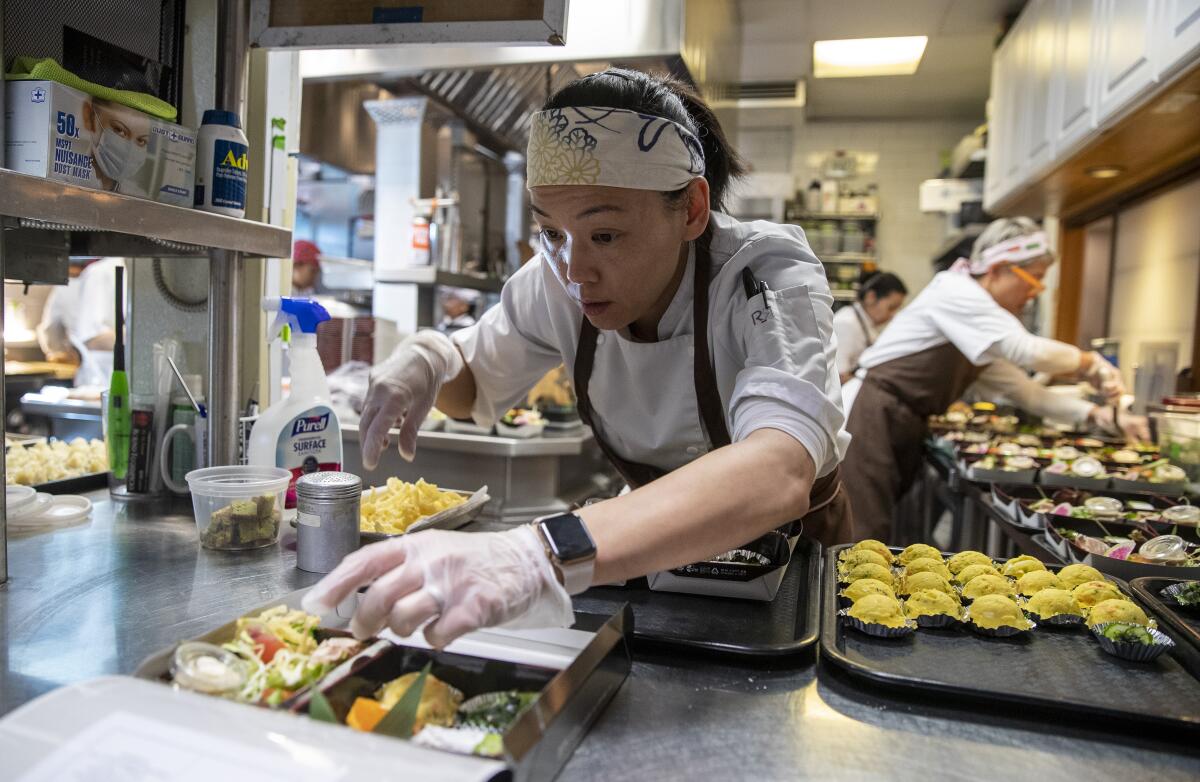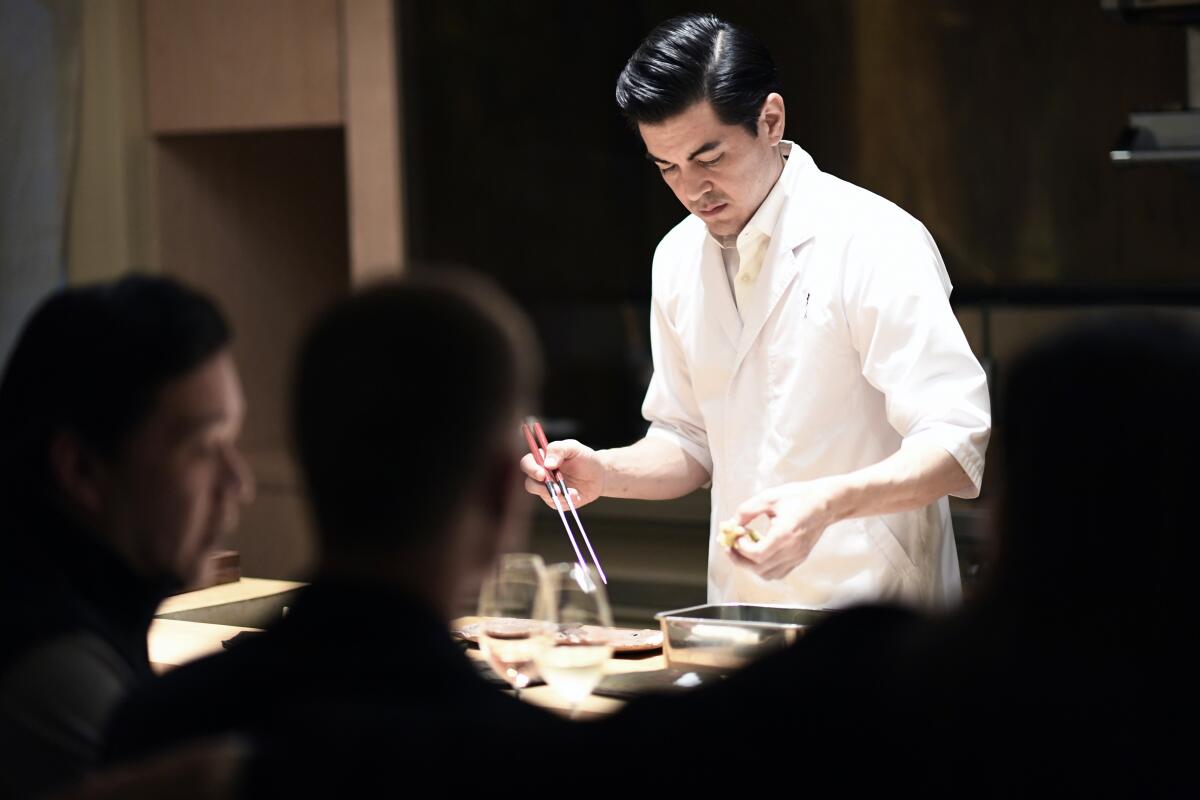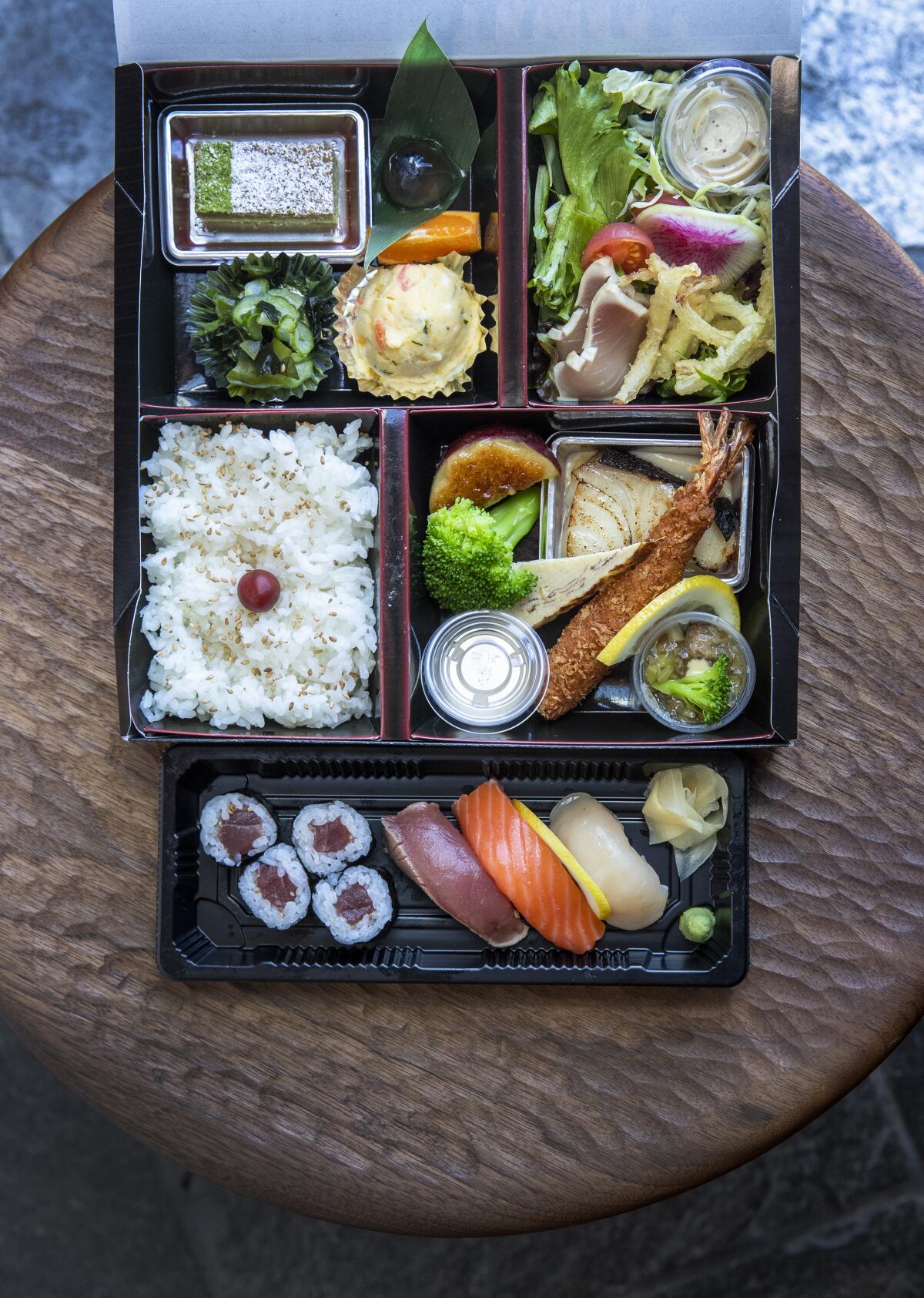Vespertine for $49, n/naka for $38: Fine dining joins the takeout game amid prolonged shutdown

- Share via
Vespertine for $49, Auburn for $39, n/naka for $38, Dialogue for $35. In a world that has seemingly turned upside down, several of the city’s most elite and exclusive dining establishments — finding themselves in the same perilous situation as every other restaurant — have joined the takeout and delivery game.
In some ways, the coronavirus shutdown has been the great equalizer as restaurants of all kinds fight to stay afloat and adapt to unfamiliar ways of doing business. Suddenly, no matter the price point, restaurants across the board are faced with bills to pay, workers to let go, suppliers to support, kitchens full of food and no answers on when it will all end.
At the celebrated and influential Alinea in Chicago, employees had to immediately figure out how to become “a mass-production kitchen” that is now churning out more than 500 meals a day, chef-owner Grant Achatz wrote on Instagram.
It’s something that would have been unfathomable just two weeks ago. Normally, such restaurants are blowout tasting-menu-only affairs, with meals that unfurl over hours and cost more than $200 per person. Most didn’t even have to-go boxes on hand.
We’ve never had to navigate these circumstances before. Even if it’s hard or it’s not perfect, or we have to pivot, we’ll find a way. Nothing about our bento or takeout menu is about profiting.
— Niki Nakayama, n/naka chef
Fine-dining restaurants were the most likely to have to spend the shutdown on the sidelines, their business models — built on a handful of diners and a procession of intricately plated small dishes with expensive and hard-to-find ingredients — hardly conducive to takeout and delivery.
At Vespertine, the futuristic Culver City restaurant where it can be difficult to tell where the plate ends and food begins, Jordan Kahn has started selling family-style meals of Wagyu beef brisket, roasted chicken, farro risotto and squash gratin. Instead of biodynamic blackberries presented by monkish servers in the restaurant’s courtyard for dessert, there are chocolate chip cookies and brownies.
A couple of miles away in Palms, Niki Nakayama and Carole Iida-Nakayama are selling bento boxes for $38. Dinner at their kaiseki restaurant, one of the hardest-to-score reservations in town, typically costs $275.
“We’ve never had to navigate these circumstances before. Even if it’s hard or it’s not perfect, or we have to pivot, we’ll find a way,” Nakayama said. “Nothing about our bento or takeout menu is about profiting. We just want to make sure that everyone from our employees to our suppliers feel supported by us in any way we can.”
A common misconception is that fancy restaurant equals huge profits. It’s often the opposite, chefs and owners say, pointing to thin margins, disproportionately large numbers of kitchen and dining room workers, high ingredient costs and a heavy reliance on diners’ willingness to splurge.
“Our margins on food at Hayato are basically zero, and most of the profit comes from big-ticket alcohol,” said chef-owner Brandon Hayato Go, who runs the seven-seat kaiseki restaurant downtown. “At the end of the day, in a restaurant the size of Hayato, the difference between a profit and a loss can be a single diner or a bottle of wine.”

A week into the citywide ban on dine-in service and Hayato is “already in the hole for tens of thousands of dollars,” Go said. After mulling over “dozens of things I would like to try and make for takeout,” he opted to close until restaurants are allowed to be fully open again.
Many other high-end L.A. restaurants, including Providence, Kato, Somni and Trois Mec, also have temporarily shut their doors, preferring to wait out the shelter-in-place restrictions currently set to end on April 19.
Chef Dave Beran considered doing the same.
“But I have to do something for our staff. Even if nothing happens, at least it keeps them mentally challenged,” he said. “We won’t make any money off of it. The dream is to break even.”
At Dialogue, Beran scrapped his Santa Monica restaurant’s 20-course, $250 winter menu and created two three-course, heat-at-home meals for $35 each, packaging them in to-go containers he grabbed from vendors in the food hall where the restaurant is located.

He encountered a steep learning curve when he introduced takeout last week at Pasjoli, his nearby French bistro. The initial menu was in keeping with the restaurant’s usual dine-in dishes: a milk-fed pork chop with fennel gratinee; trout meunière; a towering Mont Blanc for dessert.
Pasjoli didn’t get a single order the first day.
“It was a poorly designed concept,” Beran said. “The reality is people don’t really want high-end takeout.”
He and his team took a few days to regroup and came up with a new menu featuring lower prices and more approachable dishes better suited for eating at home: grilled cheese with caramelized onions, fried chicken, a cheeseburger with waffle fries.
That’s the unexpected, albeit small, upside for fine-dining chefs still operating during this unprecedented period: the rare opportunity to demonstrate their culinary skills beyond highly technical, fancy food.
“Jordan is actually an amazing home cook,” Beran said of the Vespertine chef; the two worked together at Alinea. “People don’t know that but he is.”
Nakayama noted that before she opened n/naka, she ran a deli in Arcadia that sold takeout bento boxes.
“We were kind of like, ‘This is like going back to our roots,’” she said.

Last week Shunji launched to-go options for the first time, including a sushi box for $48 and a deluxe sushi bento for $70. So far sales have been better than expected, with a lot of support from neighbors who live close to the West L.A. Japanese restaurant, but it’s been an adjustment.
“Takeout is a new thing for us, so it wasn’t very smooth,” chef-owner Shunji Nakao shared on Instagram. He’s also concerned about the ability to get fresh fish from his suppliers as the pandemic stretches on.
Fine-dining chefs note that carryout meals should not be taken as a representation of what the full-scale experience is like at their restaurants; in nearly all cases, the food is dramatically different from what’s served in the dining room.
And interim takeout or not, they’re bracing themselves for what’s next.
All Americans are going to take a hit in their pocketbooks and splurge less frequently as the economy recovers. ... When people don’t have any money, even ordering a pizza is a splurge. Pizzerias are going to suffer too. But the problem with fine dining is that it’s a splurge for everyone.
— Brandon Hayato Go, Hayato chef
“I’ve been devastated by this crisis and my restaurants are not in good shape,” chef Corey Lee, who runs lauded tasting-menu restaurant Benu in San Francisco, wrote on Instagram on Monday. “The hard reality is we may not emerge from this as restaurant owners.”
Saying the “future of the entire business is in jeopardy,” Go, of Hayato, worries that even after restaurants are permitted to open again, high-end places will be “in a particularly difficult situation after this.”
“All Americans are going to take a hit in their pocketbooks and splurge less frequently as the economy recovers,” he said. “The rest of this year is undoubtedly going to be hard. Of course, for each person a splurge is different — when people don’t have any money, even ordering a pizza is a splurge. Pizzerias are going to suffer too. But the problem with fine dining is that it’s a splurge for everyone.”
More to Read
Eat your way across L.A.
Get our weekly Tasting Notes newsletter for reviews, news and more.
You may occasionally receive promotional content from the Los Angeles Times.











